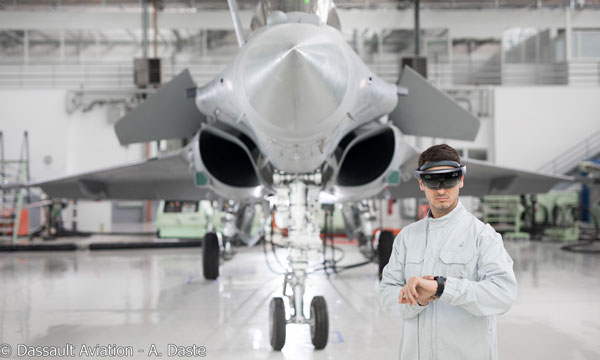Factory 4.0 working for MOC |
| Helen Chachaty |
|
|
23 MAY 2019 | 805 words
|
 |
© Dassault Aviation/A. Daste |
|
|
|
"A major objective for Armed Forces ministers", MOC (maintenance in operational condition) regularly has fingers pointed at it, especially in the aviation domain, when aircraft availability rates (which are often too low) are mentioned. Ageing fleets, obsolescence or conversely recent equipment with more advanced technologies and major commitments to overseas operations are all factors which help increase maintenance costs, against a background of heavy budgetary constraints.
"The main objective is to find solutions to contain or reduce costs, given the scale of budgetary and operational constraints", says the foreword to a recent study from the IRSEM (the Military college strategic research institute), entitled "Le potentiel des technologies de l'industrie 4.0 appliquées au MCO des équipements de Défense" (The potential for industry 4.0 technologies applied to Defence equipment MOC). Written by Josselin Droff, researcher at the IDEDN's Defence Economy Chair and ICA Benoît Rademacher, director of the IRSEM's Weapons and Defence Economics domain, the report explores four major areas of application: connected objects, 3D printing, virtual reality and augmented reality, and automation and the use of robots/cobots (collaborative robots).
While "factory 4.0" goes hand in hand with "MOC", concrete applications present disparities according to domain, although "procedure digitisation is one of the levers for performance", according to an information report by the French MPs Olivier Becht and Thomas Gassiloud published in 2018.
In relation to "the Internet of Things" and connected objects, such as RFID chips, HUMS and big data for preventive and predictive maintenance, it would seem that "there is more 'potential' than 'actual results'", according to the authors. However, the authors do temper their statements by mentioning the studies carried out by the DGA in the area; four are to do with aeronautics, including one programme which predicts the development of a "data collection and processing architecture to optimise the operation of helicopter engines". Because the limits of this technology cluster cover not just data security, but also intellectual property or the actual relevance of the data collected. In particular, the document quotes the example of the Rafale and the A400M which generate 4 kilobits and 200 gigabits of data per flight respectively. Of the 200 gigabits of data collected for the tactical transport aircraft, only 0.1 gigabits is "actually usable for maintenance". This puts the pre-eminence of big data into perspective.
The second domain quoted in the IRSEM report covers all technologies related to 3D printing. While the technique is currently being used to manufacture certain aircraft parts - over a hundred for the American F/A-18 - and it makes it easier to manufacture small quantities of spare parts, in particular to handle obsolescence, 3D printing is still coming up against the cost of the equipment and training required. However, the technique is set to develop, as shown by the projects carried out on M88 and TP400 engine parts by the industrial companies concerned, but also the studies launched by the DGA: these cover the feasibility of additive repair for certain Rafale engine parts, in partnership with the SME BeAM.
The third key domain is virtualisation technologies (augmented reality and virtual reality) to "increase MOC task speed while simplifying them". Among the application projects quoted by the study are the use of a headset which uses augmented reality (based on Microsoft's HoloLens) to inspect the combustion chamber of Noelle 180s, the Mirage 2000's APU. The headset has been tested since the end of 2017 at the AIA in Bordeaux, with the DGA which is targeting a 30% reduction in inspection time and a fall in error rates. Virtualisation is also a part of maintenance training, as shown by the RAMSES programme which has been deployed since 2014. Developed by Dassault Aviation, Nexter Training and the French Air Force, it enables the simulation of actual situations, aircraft walk-around, removal and installation of equipment and even hydraulic tests.
The final domain explored by Josselin Droff and the ICA Benoît Rademacher covers task automation and the use of robots and cobots, for both tasks and logistics. In particular, the report mentions a project launched by the new DMAé, in partnership with AFI KLM E&M, which seeks to evaluate technological solutions to optimise the maintenance tasks performed at NT1 level (line maintenance). This would involve deploying a drone to carry out a visual verification operation and detect any impacts. One other example is in the missile domain, with the use of the cobot to support the operator in removing the Scalp's turbojet engine, as part of its mid-life upgrade. The cobot is then used "as an extra hand for the operator".
The IRSEM report concludes that "the four technology clusters [...] present potential in terms of maintenance for Defence equipment", in order to improve "productivity and quality of service", with a gradual and "discreet" introduction into the different entities responsible for maintenance, whether government or industrial organisations.
|
|
| |
| |
They made this section possible |
|
|
|
|
|
|
|
|
|
|
|
|
|
|
|
|
Top stories |
|
|
|
|
|
Top stories
|